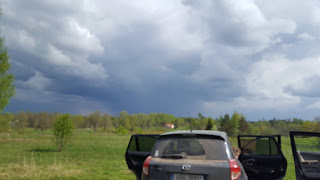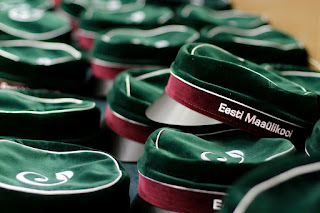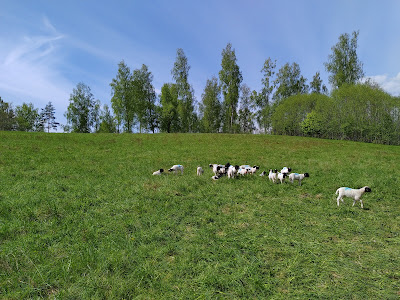The First Summer aka My Estonian Childhood
This story starts in April, when I buy my car. It’s a small off-road car, and although I struggle with increasing my environmental impact in this way, I need a car (and the car-thing in Estonia’s countryside is worth its own blog post). It’s a typical first car, 15 years old, some scratches and a little rickety, but it meets all my needs: Not too big, so I can still find a parking spot in the city, but big enough to transport all my lab equipment and some people and a dog. It has four-wheel drive, the main factor for buying a car that is definitely not first choice for an environmentalist – but I’m gonna need to drive through muddy fields a lot. I name it Hugo, because its face reminds me of a dog named Hugo, but as a friend says: “Hugo – not in the best shape but he has seen some stuff!”
I pack my essentials, stocks of vegan foods, and boxes full of laboratory utensils and an old centrifuge in the trunk and start driving. Snow is still quite likely, nights are still frosty, so I’m wearing my winter boots, a warm sweater, a hat, and Hugo is wearing his studded winter tires. Five weeks later I will return to Tartu in a summer dress.
This is the beginning of my field work for the PhD. During the lambing season I will collect data about newborn lambs: Their birth weights, blood samples to measure marker proteins in, intestinal microbiota DNA (taken with a rectal swab), and fecal samples. A similar project as done a few years ago, but then they took blood samples once a week, meaning, they drove to the farm one day per week. I will do it more precisely and take the samples on day 10, 17, and 24 for the individual lambs – which means I take samples every single day. Because the farm we cooperate with is a one and a half hour drive away from Tartu, the family has offered that I live with them. I have only talked to the farmer two short times, but never met his wife or the children. The daughter whose room I’ll be sleeping in hears about me for the first time the morning I arrive. Now I have a few days to get to know their routines and set up my little laboratory corner in the stable, then the lambing begins.
But what also starts here, is my Estonian childhood. I am extremely lucky with the family: we love each other so much that they basically adopt me. “No problem, just one more child, I can make you vegan porridge”, says Liilia, the mother. There are five kids, and of course, each of them has their own preferences in food.
“I hope you like music”, says Ants, the father, “because they are learning trumpet, violin, drums and piano in this house”. 15-year old Aale, who is sharing her room with me, will also be my assistant for the next few weeks, as taking blood from a lamb when you’re on your own is a challenge my supervisor is fortunately not making me face. 9-year old Meel introduces me to the Border Collies Kalle, Mari and Pini, and little Aho tests my language skills: “Do you know what this is?” – “Yes, it's a chair” – “But do you know what that is?” – “Hmm, I’m not sure, was the word stair?” He giggles. “No, it’s a ladder!”
They all speak Estonian with me, the boys out of necessity, the others out of politeness – this is my biggest learning opportunity yet. When things get too complicated or topics get a bit deeper, we can always switch to English. But the boys are my best teachers. With them we learn to describe the words that I don’t know, they correct every mistake I make, and teach me so many new words and expressions. Mostly I lean to drop my shyness about speaking Estonian. If I say something wrong, like “And in this recipe you have to throw the cream”, they will know what I mean, and teach me the correct word or grammar.
I learn what childhood feels like in Estonia, not just by learning how to properly make flower crowns from dandelions. We have oat porridge, rice porridge, or semolina porridge for breakfast, always with homemade jam. We drink tea form different herbs that were collected around the farm. And because the sheep don’t have to be milked in the morning, our days start slow. Breakfast is at nine. I usually don’t start sampling before eleven. The kids are home schooled – and so even the youngest gets to stay up until 11 pm.
I join them for the weekly grocery shopping in the nearest village that has a store (23 km from the farm), I make pancakes on Sundays, because in Estonia, we eat pancakes on Sundays, I watch children’s movies in the evenings, play with the dogs or on the homemade swings. I drive the kids to the ugly city Valga on the Latvian border, where they go to music school. In the car, we always all sing along to the British pop songs and Estonian folk songs. I help to feed the sheep. Drink birch and maple juice, which they take from trees in the springtime. I weigh the lambs in a bucket on a kitchen scale, draw their blood samples, and milk some colostrum from their mothers, which I also need for my study. While I do my lab work, Aale and I chat about sheep, farms, music, and boys. This is my daily life.
I even have school. While we were organizing the room in the stable that is used for storage most of the year and as a bedroom for lambing helpers in spring, we found a workbook for biology for second grade. So now I sit down on the dining table with the others, and while Hava is listening to an online lesson, Loo is reading her history book, Aho is practicing his spelling, and Meel working on some English exercises, I open my “loodusõpetus töövihik 2. klassile”. The boys help me by explaining the words I don’t know and coloring in the pictures.
Then I learn how to properly sing “Palju õnne sulle”- it goes with the same melody of “Happy birthday to you” as in any other language, but is repeated several times, each one faster than the previous, until everyone is just laughing.
On the First of May, they raise the Estonian flag, and Ants plays the trumpet on the verandah. It’s warmer now, the seven-year old keeps losing his clothes all over the place, and I walk around the garden barefoot and hang out in the sun with the dogs. There is a total of nine dogs on the farm, each with their own job. To me, this time feels a bit like a vacation, being here, but I actually make a big step forward in my research. But the slow mornings, all the hanging around enjoying my surroundings… There is no point in hurrying. We live on a farm, there will always be more work, it will never be done, no matter how fast we work. Lambs are being born all the time. Animals are always hungry. And there is always a project around the house. And Ants says: “Why should I have told Aale that you would be coming before you actually did? Things can come up, plans can change; there is no point in worrying about the future.”
After a long winter in the city, with the pandemic, and the occasional loneliness, living in the countryside, with a family, gives me the space to finally breathe freely again. Being here makes one forget that there is a global health crisis, that people don’t find a parking spot (just park on the field!) or that you would be able to hear when your neighbors are doing. As I get back to Tartu in the middle of May, the town seems huge to me, too loud, too full of people, crammed almost. And remember: Tartu has just over 93,000 inhabitants! But from now on, I will always have this quiet place (well, quiet apart from the children screaming and the sheep bleeking) to come back to. And I don’t even need to ask- all guests here just announce themselves. Farmers are always home and never have time. Also, in this house, there is always space for the people they like.
Spring was extremely short this year, summer is already here. I lay out the cowslips to dry for tea. Make fresh peppermint tea. Start vegetable experiments on my windowsill and find a community garden around the corner (I can finally compost!). Dig out my summer dresses. Make my own jam.
But as I am now practically a seven year old Estonian, it’s time to start music school. I want to learn an instrument, and my Estonian family has encouraged me to try the karmoška. It’s essentially a smaller and lighter cousin of the accordion, said to be easier to play, and although originally from Russia, played a lot in Southern Estonia. I don’t know if there even are private music teachers in Estonia, most are organized in music schools, and those are easiest to find. I ask the one closest to my home if they would be willing to teach an adult who might need to communicate some things in English. They say yes, and could I come by ion a certain day to talk more. As I get there, they ask if I would be interested in the theory lessons as well, and I guess that can’t hurt. Estonians are generally well educated in music, and I want to integrate more. “Allright”, the director of the music school says,2 and what would you like to sing for us?” I ask her to repeat the question in English, but I have understood correctly. I’m not just here to see the school, this is an audition. Thank god I can count on Curly Strings, she likes my singing, I have proven that I’m not completely without any musical talent, so I’m in. In the fall, my lessons will start.
But first, summer. Estonian summer. It’s
actually stressful. Every free minute is spent outside with friends, laying in
the grass, swimming in lakes and rivers, collecting fresh birch leaves to make
a “viht” for the sauna, and barbecue over the open fire. I’ve actually not seen
anyone barbecue over a commercial grill at all in Estonia. And while you
constantly meet people, at the same time, nobody ever has time. There are
berries to pick, there is jam to cook. Everybody does go to work, but people
leave in the middle of the day, and between midsummer (June 24) and the end of
August, the parking lot in front of our building is constantly empty, nothing
much happens. But well, as a PhD student, there is always a lot to do.
Festivals are happening, birthday parties that last 24 hours. You have to work
in the garden and prepare for winter y collecting everything nature has to
offer. It’s too light to go to bed before midnight, and too hot to sleep past
six in the morning. The time of the famous white nights has begun, where around
two at night you look at the horizon and wonder if it’s still sunset or already
sunrise and it never gets completely dark. There is no sleep, there is no time
to do anything inside the house or apartment. So now I finally understand why
Estonians sleep and rest so much in the winter. Where all that jam and herbal
tea comes from. Why they complain about the darkness and the cold. I even
understand why supermarkets are always open until 10 pm: in the summer, that’s
basically early evening. Summer also means: Mosquitoes. If you’ve ever been to
a tropical country – you have no idea. Seriously, everybody just runs around
slapping their arms and trying to get the bugs off, dusk and dawn are
unpleasant times – and dusk and dawn, as I said, are really long.










Jede Jahreszeit bringt neue Herausforderungen – wie akademische Prüfungen. Mit prüfung schreiben lassen finden Studierende einen hilfreichen Begleiter, der ihnen hilft, komplexe Themen zu verstehen, strukturiert zu bearbeiten und jede Prüfung souverän zu meistern.
AntwortenLöschen